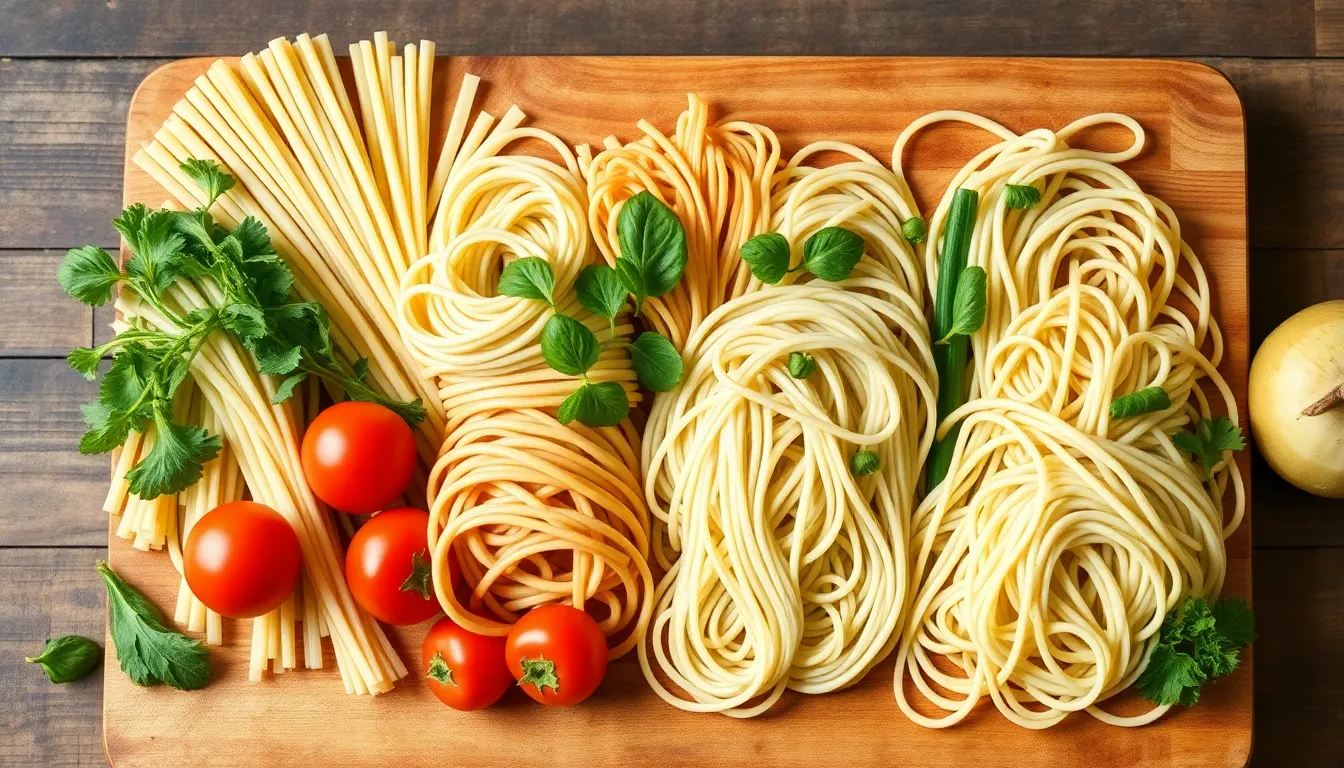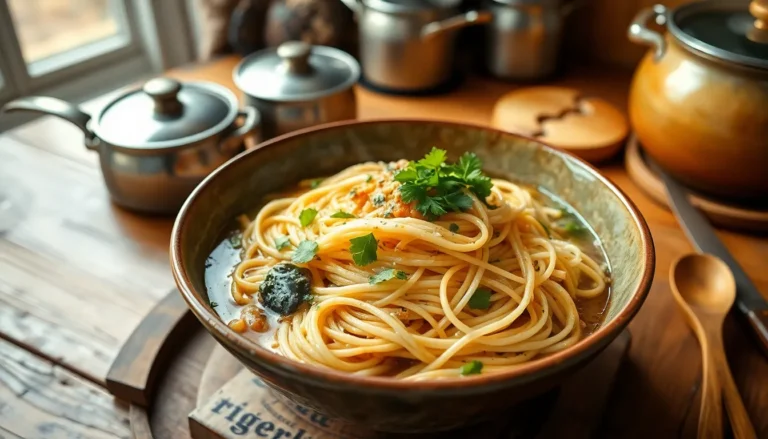Table of Contents
ToggleWhen it comes to zavagouda, the noodle choice can elevate this dish from ordinary to extraordinary. Picture this: a steaming bowl of savory goodness, where the right noodles dance with the rich flavors of the sauce. It’s not just about filling your belly; it’s about creating a culinary masterpiece that’ll have your taste buds singing.
Understanding Zavaguoda
Zavagouda relies heavily on specific noodle types that complement its rich flavors. Traditional selections include egg noodles, rice noodles, and even whole wheat options. Each noodle type brings unique texture and taste, enhancing the dish’s complexity.
Egg noodles contribute a soft, chewy texture that pairs well with the dish’s sauce. They absorb flavors effectively, allowing for a delightful taste in every bite. Furthermore, rice noodles offer a gluten-free alternative that maintains a light, delicate structure for those avoiding gluten. Whole wheat noodles provide a nutty flavor and additional fiber, creating a heartier version of zavagouda.
Choosing the right noodles significantly influences the overall culinary experience. For instance, using egg noodles might appeal to those seeking an authentic feeling, while rice noodles could attract health-conscious diners. Desired outcomes vary based on individual preferences, so it’s crucial to consider dietary restrictions and personal tastes when selecting noodles.
Experimentation with these different types can result in interesting variations of zavagouda. Whether one prefers the traditional approach or a modern twist, noodle selection remains a central part of the dish. Ultimately, understanding the characteristics of each noodle type helps in crafting a satisfying meal that excites the palate.
Types of Noodles Used

Selecting the right noodles plays a crucial role in the creation of zavagouda. Various noodle types contribute distinct flavors and textures to this dish.
Traditional Noodles
Egg noodles hold a traditional place in zavagouda recipes. Chewy and soft, they absorb the dish’s flavors well. These noodles enhance the overall experience with their unique texture. Rice noodles are another popular traditional option. Offering a gluten-free choice, they bring a delicate mouthfeel to the dish. Whole wheat noodles also feature prominently in traditional preparations. Their nutty flavor and added fiber provide a heartier texture that complements the ingredients beautifully.
Modern Variations
Modern interpretations of zavagouda introduce exciting noodle options. Zucchini noodles, or “zoodles,” offer a fresh and low-carb alternative. Spiralizing zucchini creates a light texture that pairs well with zavagouda’s rich flavors. Soba noodles, made from buckwheat, present a nutty flavor and unique texture. Their inclusion adds a healthy twist, appealing to those seeking whole food options. Additionally, gluten-free pasta made from chickpeas or lentils caters to those avoiding gluten. These modern alternatives expand culinary possibilities while maintaining the dish’s essential character.
Preparation Techniques
Selecting the right preparation techniques enhances the flavor and texture of zavagouda. Proper cooking and mixing ensure that the dish reaches its full potential.
Cooking Noodles Perfectly
Cooking noodles requires attention to detail for the best results. Begin by boiling water, making sure to salt it adequately for flavor. Rice noodles need about 5 to 8 minutes to soften, while egg noodles typically require 6 to 10 minutes. Whole wheat noodles should be cooked for 8 to 12 minutes, ensuring they achieve a tender texture. Checking the noodles for doneness a minute before the suggested time helps prevent overcooking. Straining and rinsing the noodles under cold water can halt the cooking process, especially for rice and egg varieties, ensuring they maintain their desired consistency.
Combining Noodles with Sauces
Sauce integration plays a crucial role in enhancing zavagouda. Begin by preparing the sauce separately to build flavors effectively. Once the sauce reaches the desired consistency, add the cooked noodles directly into the pan. Toss them gently to coat every strand evenly in the sauce. Using a higher heat during this step can help marry the flavors together. For those opting for modern alternatives like zucchini noodles, sauces should be kept slightly lighter to prevent excess moisture. Ensuring the right balance between noodles and sauce dictates the overall appeal of the dish, making this step essential in achieving culinary excellence.
Popular Recipes
Zavagouda recipes thrive on the choice of noodles, directly influencing texture and flavor. Egg noodles serve as a classic base, becoming soft and chewy when cooked correctly. They absorb flavors well, enhancing the entire dish.
Rice noodles act as a gluten-free alternative, offering a delicate texture that’s easy to integrate into various flavor profiles. Their lightness suits sauces and ingredients commonly paired with zavagouda, making them a popular choice for those seeking lighter options.
Whole wheat noodles add a hearty touch with their nutty flavor, providing extra fiber for a more nutritious meal. This choice appeals to those wanting a heartier, wholesome experience.
Modern takes on zavagouda include zucchini noodles, known as zoodles, which create a low-carb alternative without sacrificing taste. The unique texture combines beautifully with sauces, and it adds a fresh element.
Soba noodles, made from buckwheat, introduce a distinct nuttiness that elevates the dish. This option excels in flavor and pairs well with the traditional zavagouda ingredients.
Chickpea and lentil pasta also offers a gluten-free option while contributing extra protein. This modern alternative caters to dietary preferences and enriches the dish’s nutritional profile.
Technique matters when preparing these noodles. Cooking them to the right texture is essential; specific times for each type ensure optimal results. Rinsing and straining prevent overcooking, preserving the essence of each noodle.
Integrating sauces effectively transforms zavagouda. Preparing sauces separately allows for even coating, enhancing flavor cohesion across ingredients. For lighter options like zoodles, keeping sauces less moist ensures a delightful balance.
Ultimately, noodle selection and preparation techniques significantly shape the zavagouda experience, inviting exploration of diverse ingredients and flavors.
Choosing the right noodles for zavagouda is crucial for achieving a delightful dining experience. Each noodle type brings its own unique qualities that can transform the dish. Whether opting for traditional egg noodles or exploring modern alternatives like zoodles or soba noodles, the selection should reflect personal taste and dietary needs.
Perfecting cooking techniques is equally important. Proper timing and rinsing can elevate the flavors and textures of the noodles. By thoughtfully considering both the noodle choice and preparation methods, anyone can create a satisfying and memorable zavagouda that excites the palate and showcases culinary creativity.




